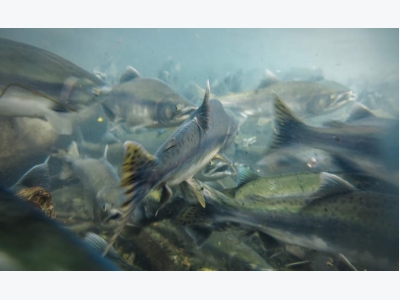5 global trends spawning seafood innovation

Closeup underwater view of a school of sockeye salmon spawning in the Kenai River, Alaska. ShutterstockPete Niesen
If you’re a talented young data scientist scouting the next frontier, where do you go? If you’re a biotech pioneer hunting for new ways to apply cutting-edge concepts, where do you look? If you’re a global powerhouse that doesn’t want to miss the next big market opportunity, what’s on your radar?
Seafood.
Seriously. That answer may be an outlier now, but soon it will be on everyone’s lips. Change in the seafood industry has been incremental only for the past 50 years or so. Now the sector is on the cusp of thoroughly reimagining products, supply chains and technologies, much like the communications sector did after the iPhone.
Five accelerating global trends are driving market demand behind this transformation: the need to predict and understand climate change impacts; wild fish stocks nearing maximum sustainable yield; product globalization and the rise of online sales; the worldwide growth of a health-conscious middle class; and aquaculture’s rapid expansion.
The need to track and adapt to climate change effects is fueling the emergence of 'seatech.'
These five trends are opening up new markets in the seafood sector, and entrepreneurs around the world are racing to capture a share of these global opportunities. We can see the transformation happening by comparing this year’s 184 Fish 2.0 competitors with those from previous years. Seafood is attracting innovative thinkers and teams with significant venture experience, and they’re applying approaches born in other industries to seafood’s toughest sustainability and supply chain challenges.
Intrigued by this shift, we analyzed our extensive data on seafood ventures and found that all the innovative ventures in our pipeline fall into four broad categories linked to the five global trends. The diagram below illustrates how these trends are inspiring innovation in the sustainable seafood sector.

Fish 2.0 Global Trends Drive Change in Seafood Markets.
Let’s look at each innovation category in more detail.
1. New tools that track climate change effects and aid fisheries management
The need to track and adapt to climate change effects — ocean temperature, salinity, currents, acidity and other factors that vary over time and place — is fueling the emergence of "seatech," a suite of data capture, analysis and visibility tools that could have more impact on our food system than agtech.
These technologies can detect algal blooms, oil spills and rising acidity levels before anyone lays eyes on them, and alert scientists, fishers and fish farmers to what’s coming. Fishers also can use the new tools to document their catch, so they can meet new traceability mandates and tell consumers the story of their fish.
2. Gear, processes and products that make better use of the seafood we catch
Gear upgrades are helping fishers reduce bycatch, habitat destruction and equipment loss. And the need to better use and manage our limited resources is inspiring creative processing mechanisms and products that reduce waste and improve the value of each fish by creating premium products such as fish jerkies or leather from fish parts previously sold for pennies or discarded.
3. Supply chain innovations that tie into globalization and online sales
Product globalization and the growth of online sales are shifting supply chains in the seafood sector just as they are in other consumer markets. We now expect to get the exact sustainable, fresh and healthy products we want, delivered to our door quickly and cheaply. Entrepreneurs are responding with direct-to-consumer seafood sales, as well as new logistics and packaging options that cut costs and boost quality. This is happening all over the world, and it’s opening new, high-value local market opportunities in countries that long have been net exporters of seafood.
4. New feeds and production technologies keyed to aquaculture’s growth
We need aquaculture to help feed a growing, increasingly health-conscious global middle class. But growth can’t happen at the expense of maxed-out wild fish stocks. That challenge is drawing biotech innovators to the hunt for new fish feeds that don’t come from other fish — a multibillion-dollar market all on its own. Others are developing technologies that help fish farmers prevent disease and operate more efficiently, so that fish losses don’t hobble growth.
An exhilarating rush of change lies ahead
The need for change in seafood has been obvious for quite a while, and these five global trends are not new for most market analysts. What is new is the growth of sustainable seafood innovations that align with these trends. And we’re excited to see that each innovation area is hooking into market growth opportunities created by at least two of the five global trends.
From the Fish 2.0 vantage point, it’s clear that we are at the start of a steep growth curve leading to a major market transformation — and the climb will be exhilarating.
This story first appeared on: National Geographic
Related news
 Tra export value rises, firms cautious
Tra export value rises, firms cautious The export of tra fish is still facing difficulties although exports for January-September hit US$1.3 billion, up 5.8 per cent over the same period last year
 Seafood export revenue may reach US$8.2 billion this year
Seafood export revenue may reach US$8.2 billion this year Total export turnover of seafood may amount to a staggering US$8.2-8.3 billion in all of this year
 The tide is changing for offshore aquaculture
The tide is changing for offshore aquaculture This story was produced by Ensia in collaboration with the Food & Environment Reporting Network, a non-profit investigative news organization.